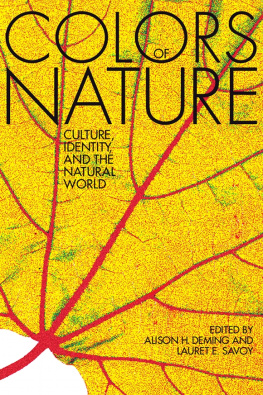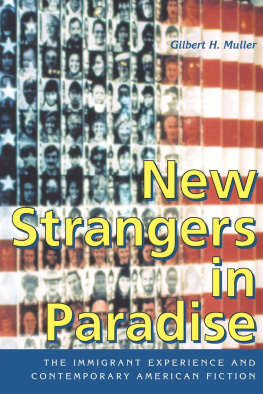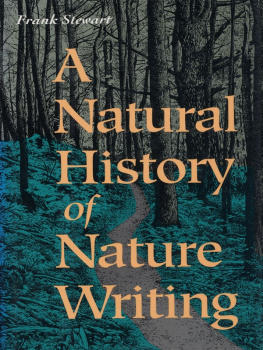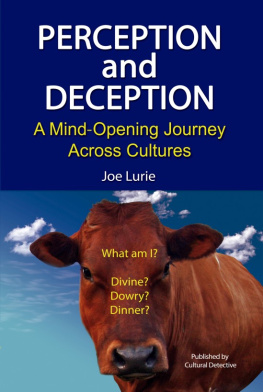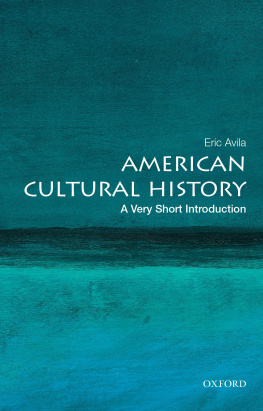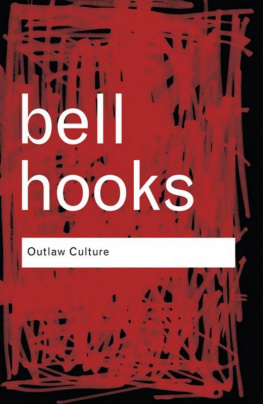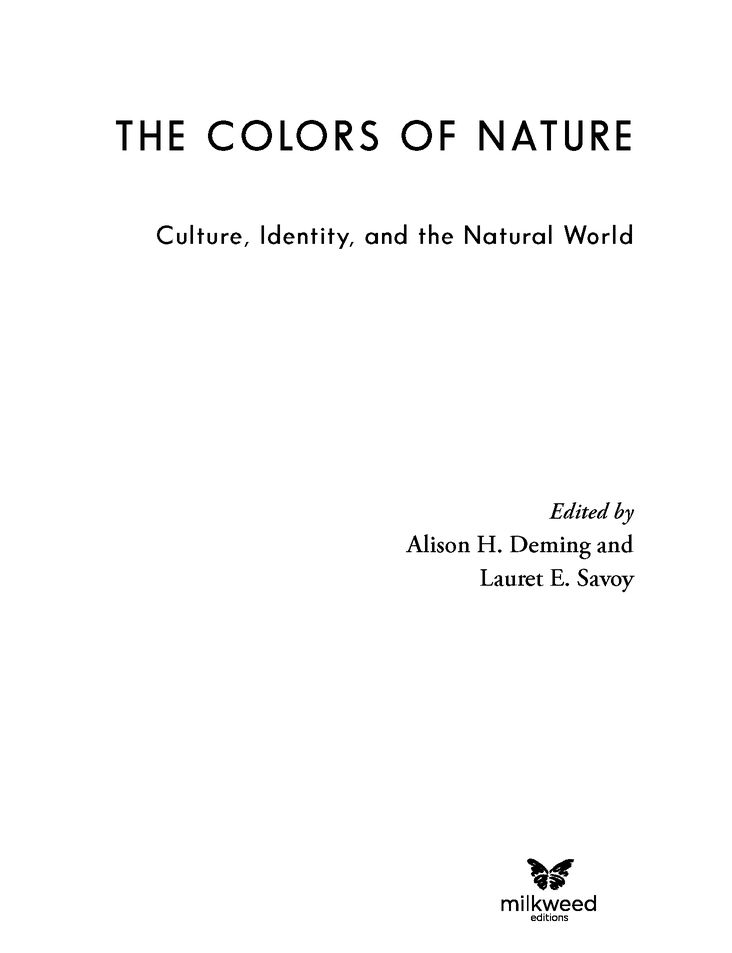Table of Contents
To the voices that remember and those as yet unheard
WIDENING THE FRAME
Lauret E. Savoy and Alison H. Deming
... most nature writing is barricaded with omissions to make it just another gated community ...
Rebecca Solnit
Despite countless claims to the contrary in recent newscasts and articles, the United States is not a post-racial society. In fact, each day offers new examples of injustice that reveal a society determined to avoid the troubled legacy of our nations founding and growth.
Consider New Orleans. Years after Hurricane Katrina made landfall on August 29, 2005, the wake of levee failure still points to long-embedded practices of de jure and de facto apartheid. For those who lacked access to shelter or higher ground, and for those who received little forewarning or relief aid, their disproportionate suffering was only another surge in a centuries-old pattern. After the Civil War, African Americans were forced to live in the least-desirable, flood-prone areas of New Orleans. Lawful segregation of the citys public housing and transportation before the mid-1960s only further entrenched this geography of poverty and race. When Hurricane Katrina arrived, then, it should have hardly been a surprise that the burden fell primarily on low-income people of color: Weeks after the levees broke the majority of homes that remained submerged were owned or rented by African Americans.
By some measures New Orleans has recovered significantly. The Brookings Institution reported in late 2010 that the citys population had exceeded three-quarters the pre-Katrina numbers, that large-scale rebuilding efforts had boosted the economy there, and that the local unemployment rate was lower than national statistics. But who has moved back and who is being counted?
Even though most of those living in the Crescent City in August of 2005 were renters and low-income residents, recovery programs have favored property owners. Thousands of displaced families still, years later, live in temporary housing (trailers and tents), or are homeless, many squatting in abandoned buildings. Thousands more, particularly low-income (former) renters and public housing residents, have not been able to return to the city as rents there climb out of reach and as mixed-income homes replace affordable housing. Those affordable public housing projects that survived Katrinamore than 5,000 unitswere demolished by the housing authority (backed by HUD and the city council), leaving only a small percentage of homes set aside or subsidized for those with little means. And corporate spending on rebuilding hasnt helped the situation, giving priority to privatizing or reducing many social services rather than ending the displacement and homelessness of poor people of color. With investment goals focused on a smaller but more affluent city footprint, redevelopment is targeting areas where the economically poor did not, or could not, live.
Reconstruction is changing the citys racial and economic complexion, rather than restoring separated families, communities, or the spiritual rootedness that made the city so culturally rich. Yet, polled by Gallup and other organizations on whether Hurricane Katrina and its impacts pointed to persistent racial inequality, fewer than half of white Americans thought so, while more than three-quarters of African Americans in the country said yes.
Do you know what it means to miss New Orleans? / and miss it each night and day.... These lyrics, first sung by Louis Armstrong and Billie Holiday in 1947, might very well be the anthem of a whole generation of New Orleanians unlucky enough to be from the wrong ward.
This is not only happening in New Orleans. Across the nation polluting industries follow paths of least power or resistance, as the federal government has persistently weakened or simply failed to implement enforcement structures and health-protection measures for communities less capable of defending themselves. The recent study, Toxic Wastes and Race at Twenty: 19872007: Grassroots Struggles to Dismantle Environmental Racism in the United States, reports that more than half of the nine million people living within two miles of hazardous waste sites across the country are people of color. The study goes on to document systemic racial and socioeconomic inequities in the siting of commercial waste facilities.
Anyone who looks closely enough can see that the ways in which the United States organizes its political system and economyfrom de facto segregation and toxic waste sites to food production and trade policiesare far from neutral and even farther from post-racial. And yet, despite clearly worded, well-researched studies proving racist policieslike Toxic Wastes and Race at Twentyand despite one of the most massive and ongoing segregated depopulations of a United States city in historyNew Orleanscitizens with great power in this country continue not to see the systematic injustices daily visited on communities of color. Why not?
The seed of this anthology was a troubling question: Why is there so little nature writing by people of color? To respond we had to decide what nature writing was, and is.
Although writings about the natural world have existed from ancient times to the present in countless cultural traditions and languages, nature writing as a distinct literary tradition in Europe and Euro-America originated in the Romantic Age of the late eighteenth century. Romanticism, as a reaction against neoclassicism, was an affirmation of imagination over intellect and emotion over reason, and it celebrated a belief in the innate goodness of nature and of human beings in their natural state; but romanticism was also defined by a sense of separation from the natural world, the belief that nature was external to human existence. That nature writing became a strand in the weave of American literature was hardly surprising considering the compelling heritage of natural beauty, grand scale, and rich biodiversity of the continent. Many of the early, Euro-American luminaries of the genre wrote about solitary explorations of wild places from a poetic, philosophical, or scientific perspective; seeing nature as a place apart, where wisdom and inspiration could be harvested for day-to-day life in the real world of cities.
In the last few decades, nature writing has ranged beyond such narratives of solitary encounters and celebrations of pristine wildness to consider degraded habitats, cascading species extinctions, and global climate changeall providing incontrovertible evidence that our uniquely American relationship with this world has become unsustainable. This more contemporary sensibility understands that nature has been wounded and degraded throughout human history, that such wounding diminishes all of us, and that the wound must somehow be healed. If this is what nature writing is, the question then remains, Why is there so little recognized nature writing by people of color?
African American, Asian American, Arab American, Latino/a, Native American, and multiracial or mixed-blood voices have profoundly enlarged and enriched our national literary identity. Yet while the previous question suggests, somewhat surprisingly, that little of that writing has had anything to do with the natural world, there is a wealth of literature on nature from culturally and ethnically diverse voices.

